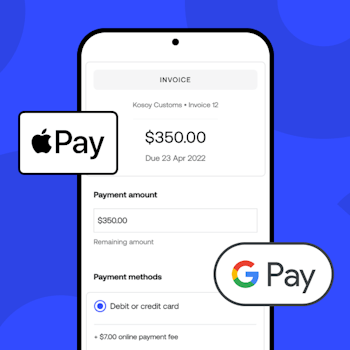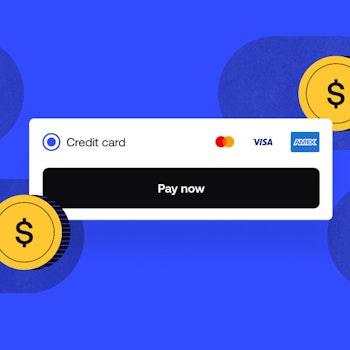
The ultimate work-from-home schedule for 2022
Modern workers enjoy the freedom and flexibility that comes from working remotely. But achieving an effective work-life balance can be challenging. That is why it helps to have a clear work-from-home schedule to establish your daily routines.
At Invoice2go, a Bill.com company, it’s our mission to promote the success of freelancers and small business owners. Today, we’ll give some remote work tips that you can use as you’re creating your own schedule, keeping you on task and motivated while working from your home.
8 ways to structure your day when working remotely
Work-from-home freelancers often gravitate to one of two extremes. Some find themselves struggling to stay motivated, while others find their work-life spilling over into every waking hour.
To help you achieve a better balance between work and home, here are some helpful tips:
1. Organize your workspace
Your laptop may be portable, but you’ll often find that you’re most productive when you have a designated workspace. Your best bet is to convert a spare bedroom into a home office so that you can partition your work life from the rest of your house.
If you can’t spare an entire room, you can at least designate a location in your house as your workspace. Avoid high-traffic areas like the kitchen or living room, and clearly communicate to your family that this space is your workspace — even if you have to politely remind them not to disturb you when you’re working!
Make sure your workspace is clean and relatively quiet. Some work-from-home freelancers report being more productive when listening to soft music, but this is up to you.
Avoid clutter and other distractions, and make sure that your workspace offers reliable internet connectivity. Invest in a comfortable chair since you’ll likely be sitting for extended periods.
Fitness fanatics may benefit from a standing desk, which can keep you productive without feeling trapped in a sedentary lifestyle.
Make this workspace your own. Even though you’re working from home, you can still personalize your home office with a few houseplants and photographs of your friends and family members. This can help you to mentally establish your desk as your official workstation, even if it’s in the middle of your house.
Don’t neglect the clutter on your actual computer, either. A desktop full of disorganized folders can be just as much of a distraction as clutter on your physical desk. At least once a week, purge old files and organize existing ones into appropriate folders.
2. Use a task list
One of the best ways to stay focused is to make a to-do list. There are countless electronic tools that you can use for this. For example, you can sync Google Tasks across all of your devices without costing a cent.
But don’t neglect the power of pen and paper or a simple dry-erase board, either. Some work-from-home freelancers prefer the tactile nature of these old-school methods, finding that it’s satisfying to physically scratch items off their task lists.
Your task list will largely be the driving force behind your work-from-home schedule. In many cases, your supervisors or clients can be instrumental in helping you map out a list of essential tasks, which you can then prioritize according to their respective deadlines or other essential criteria.
Of course, this shouldn’t prevent you from setting some priorities on your own. It’s easy to procrastinate when you don’t receive direct supervision.
Keep yourself on task by breaking long-range tasks into smaller segments. Assign yourself deadlines for each milestone so that you can complete a project at a steady, reasonable pace and make adjustments along the way if needed.
3. Establish precise work hours
The best way to achieve a work-life balance is to establish working hours and a regular work-from-home schedule. This means setting precise working hours and communicating these hours to your family members or housemates. Stick to your plan and start and finish at the same time each day.
Posting your work schedule can remind you—and your family—about your commitment. It can help you to establish clear workday rhythms that keep productivity high throughout the day. Don’t forget about your lunch break!
Some work-from-home freelance opportunities may require you to collaborate with teammates, so setting regular hours can help to facilitate communication. You can even set aside specific times of the day that are dedicated to following up with emails or jumping on a call.
Establishing a clear work-from-home schedule and sticking to the same schedule can also ensure that you have a clear ending point for each day (but more on this in a minute). Establishing a clear “quitting time” can help your family be more understanding of your commitment to remote work while also letting you mark the boundary between “work time” and “home time.”
4. Be sure to get ready for the day!
Sure, it sounds silly, but dressing like a professional can make you more productive. Scientists call this “enclothed cognition,” which means that your brain attaches “symbolic value” to the clothes you wear. In other words, you’re more motivated when you wear a suit and tie than when you wear sweatpants (although we do love how comfy sweatpants are).
You can take advantage of this by practicing good grooming and wardrobe habits, just as you would for the regular office. Brush your hair. Shave. Wear something professional. You just might surprise yourself by seeing your productivity increase dramatically.
In fact, in an age of teleconferencing and video calls, this might be non-negotiable. Maintaining a professional appearance not only helps you to stay productive but can also send a strong message about your work ethic to your coworkers, clients, and anyone else who might see you throughout your workday.
5. Schedule times to check-in
As much as work-from-home freelance professionals pride themselves in being their own bosses, individuals also have to exist in a web of business relationships.
Many freelancers still have to answer to a supervisor for particular projects, depending on the nature of the assignment or their specific contractual obligations. Other freelancers have to coordinate with team members or professional partners throughout the workday.
Depending on the nature of your work, you may also need to check in with your actual clients to provide progress updates or receive additional instruction throughout the day.
Regardless of the reason, your work-from-home schedule should provide ample time to check in on these various business relationships.
Work-from-home freelance opportunities don’t typically come with sick leave or vacation days. If you need time off, you’ll need to coordinate your time away with your supervisors, clients, coworkers, and anyone else that relies on you.
Just like it’s important to schedule time to coordinate with your coworkers, it’s equally important to communicate times that you’ll be unavailable. You can easily stay accountable to your communication schedules by setting your “out of the office” notifications or turning off your notifications after hours.
6. Remember to take breaks
Every work-from-home schedule should set aside time for short breaks throughout the day. And by breaks, we mean time spent away from your workstation. After all, working from home gives you the best employee break room you’ll ever have: your own kitchen!
Schedule time to grab a healthy lunch during the day and eat at your kitchen or dining room table — not your desk. This can be a time to reset your mind, which can help you be more productive during your afternoon or evening hours.
Lunch isn’t the only break you should be taking, mind you. Data reported from Forbes reveals a strong correlation between employee break time and productivity. Schedule a brief, 15-minute break at least twice a day — once in the morning and in the afternoon.
In addition to increasing productivity, these frequent breaks can be good for your health. Stepping away from your desk and the computer screen can lessen fatigue, reduce eye strain, and minimize the risk of complications associated with repetitive movements (e.g., typing).
7. Celebrate your small wins each day
One of the most unexpected challenges of being a work-from-home freelance employee is that you won’t always get regular feedback the way you would in a traditional workplace. For some workers, this leaves them feeling a little unsure about whether they’re doing a good job.
Pat yourself on the back. First of all, working from home isn’t the luxurious experience that many people make it out to be. Remote work takes dedication and discipline, and you already have that in spades.
Your ability to freelance from the comfort of home is testimony to your talents and skills, and that’s something to be genuinely proud of.
Here’s a tip: keep a file of positive words of encouragement. It might contain cards, letters, or even past reviews from employers and clients.
When you’re feeling down or discouraged, open up this file, and remind yourself of your past success. It’s a reminder that you’re making a valuable contribution to the public good.
That doesn’t mean that you should ignore criticism. Depending on the nature of your freelance work, you may have clients that are less than impressed with your output. It’s tempting to let these experiences discourage you. Instead, treat them as learning experiences. Find ways to integrate their input to grow both as an individual and a professional.
You may someday look back at those experiences and realize that your critics became the catalyst that drove you forward, while your initial setback became part of your story of success.
8. Make a clear division between work life and your personal life
Perhaps most importantly, freelancers should establish a clear, regular quitting time—and stick to it! The quickest way to derail your work-life balance is to work outside of the bounds of your work-from-home schedule. Not only will this exhaust you, but your work could easily come between you and your family or even cause a rift in your relationships.
If you’ve been following our advice so far, you’ve already established a clear, regular workday schedule. Stick to your plan by setting an alarm on your phone, letting you know that you’re done for the day.
When you hear the alarm, allow yourself to hit “snooze” no more than one time, which should give you just enough time to wrap up what you’re working on and get back to the “real world.”
For some freelancers, this is easier said than done. Digital technologies and global collaborations have all but eliminated the typical 9-to-5 workday. Thanks to smartphones, the office can reach out and grab you through the device in your pockets.
After-hours work might indeed feel urgent, especially when it comes to you in the form of texts and emails from clients or supervisors. But working outside your freelance daily schedule should be the exception, not the rule.
Communicate your boundaries to your clients and coworkers, and let them know that you’ll be largely unreachable after working hours. Set up an “away” message on your email so that those who contact you will understand that you’ll respond the following day.
These habits might sound countercultural in today’s 24-hour business world. But they are essential for your mental health, professional life, and social relationships.
They might also communicate something about your discipline and dedication. Your clients might appreciate working with someone who makes their family a priority. At the very least, they will respect your time.
Moving from routine to reflex
You can use these work-from-home tips to adjust your typical workday routines. But after a few weeks, routines can start to become habits.
Conventional wisdom has insisted that it takes 21 days to develop a habit. Still, according to the Harvard Business Review, this isn’t true for everyone. Building a habit takes time, and it takes dedication. Rome wasn’t built in a day, so why should your freelance career take off overnight?
Parents who rely on freelance work have an additional incentive to achieve a balance between work and life. Modeling good habits can set your children on a path toward achieving this same balance of workday discipline and family devotion, allowing you to impart a greater legacy than a freelance business alone.
You likely chose freelance work so that you could be your own boss. Don’t be afraid to act like it! Establishing these habits could set you on a positive trajectory for the rest of your career. So get started today!
How do you stay productive while working remotely? Are there habits or routines that work well for you? Join the conversation in the Freelance Forum and stick around for more helpful tips for freelance success.
Related Articles

How to accept credit card payments on Invoice2go in 3 simple steps

Accept payments online via Apple Pay and Google Pay

Must-not-miss write-offs as you wrap up 2022 year-end finances

5 ways accepting credit and debit card payments helps your business stay resilient

4 easy ways to increase cash flow today

What is Small Business Saturday and why is it important?
The features and surprising benefits of a well-designed packing slip
